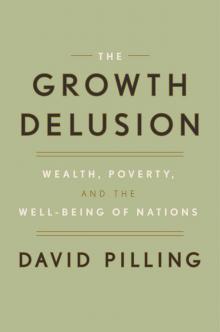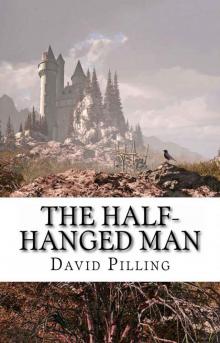- Home
- David Pilling
The Growth Delusion Page 13
The Growth Delusion Read online
Page 13
The Chinese government acted, issuing its first-ever air-pollution red alert. That meant closing 3,200 schools and advising children to remain indoors. Private vehicles were banned on alternate days according to their license-plate numbers, pulling 2.5 million cars off the road at a stroke. When drivers did venture out, they put on their headlights to penetrate the blackness. Tiananmen Square was shrouded in darkness. Thick, sulfurous air hovered over the world’s largest public gathering space, curling around the giant portrait of Mao Zedong and the ancient walls of the Forbidden City. Even the bulkiest of buildings, including the tangled steel exterior of the Bird’s Nest stadium built for the 2008 Olympics, were barely visible in the filthy air. Barbecues were banned. So were fireworks, a favorite Chinese pastime. Factories were shut, construction halted.
Still, many Beijing residents struggled on, performing aerobics to blasted music in the ghostly parks or braving the gloom to trudge to work. One foreign reporter took to Twitter after witnessing a small scene of defiance—or madness. In an improvized “Beijing haiku”1 he wrote,
A man on a bench in code red smog
pulls down his mask
to drag on a cigarette
I have had plenty of experience of Beijing’s hazardous air. An enchanting city on those rare occasions when the skies are a crisp eggshell blue, on the days the air turns vile China’s ancient capital is a vision of hell. Skin smarts in the chemical-laden air. Eyes water. Lungs heave with phlegm and dust. On a bad day in Beijing the air-quality index tops 200. We know this because the American embassy started taking measurements from its rooftop, releasing data on social media in an effort to embarrass the Chinese authorities. According to US standards, if the air-quality index drifts above 50, you are at the upper limit of safety, though Beijing residents treat anything below 100 as reassuring. A typical tweet from the embassy, this one from Tuesday, February 25, 2014, went, “440. Hazardous. Health alert: everyone may experience more serious health effects, please avoid physical exertion and outdoor activities.” A US official once described a reading above 500 as “crazy bad.” During the worst of the Airpocalypse, it edged above 1,000.
Chinese air pollutants include sulphates, ozone, black carbon, desert dust, mercury, and acid rain. The carbon-laced soot particles produced by cars, cooking stoves, and factories have a diameter of less than 2.5 micrometers, penetrating deep into lung tissue and making it easier for other toxins to be absorbed. This can cause asthma, bronchitis, shortness of breath, and chronic respiratory problems. The Lancet estimated that in 2010 air pollution in China contributed to the premature deaths of 1.2 million people, 40 percent of the world total of those dying of similar causes.2
From a health point of view, the data being streamed from the American embassy’s rooftop were more important than the level of growth, a number over which the Chinese government—and to a great extent the Chinese people—had been obsessing for years. But until recently information on particulates was actively suppressed.
By 2017 everyone in China, from President Xi Jinping on down, had become more conscious about the environment. Even then old obsessions were hard to let go. That year many viewers expressed deep admiration for a character in a hit television show, In the Name of the People, a fifty-five-episode series sometimes described as China’s House of Cards. One of the characters, a local party chief named Li Dakang, exhibits a single-minded devotion to economic growth. “There is nothing wrong with demolishing the old China,” Li says, explaining why the country must push on with development even in the face of public protests. “There will not be a new one without demolishing the old one.”
According to the New York Times, Li “sometimes neglects the negative effects of a headlong pursuit of growth. He does want to protect the environment, but it is his obsession with gross domestic product that has won him wide admiration among viewers and inspired Internet memes.” One read, “Don’t bow your head. The GDP will drop if you do.”3
* * *
—
Six months before the Airpocalypse, on a humid day in April 2015, I head out by taxi through the congested streets of Beijing. The sky is a uniformly gray veil over the city, but the air is good by the capital’s lamentable standards. Our battered car rattles along the second ring road (there are now seven) and past the Lama Temple, a Tibetan place of worship that began life as a residence for court eunuchs in the seventeenth century. We head farther toward the outskirts of the vast city, where futuristically shaped skyscrapers give way to less imposing architecture, ending up at a slabby sand-colored building occupied by the Chinese Academy of Sciences.
I’ve come to see Niu Wenyuan, a small man in his mid-seventies who ushers me into his office and proceeds to smile and nod encouragingly at everything I say during our ninety-minute encounter. Niu’s face, like that of many Chinese of his generation, is etched with a rugged dignity. He is a renowned economist, an adviser to the state council (China’s cabinet), and the recipient of a 2011 award from the Chinese government for his work on environmental protection and sustainable growth. He is also the inventor of China’s “green GDP.”
In the office are photographs of Niu with various Chinese leaders, including Hu Jintao and Wen Jiabao, the former president and premier respectively, who ran the country for the decade before Xi Jinping took over in 2013. When Niu is making a point, he moves his hands extravagantly through the air. When his thought is complete, he crosses his arms and smiles benevolently. Throughout our discussion he drinks aromatic tea from a modest silver flask, which his secretary periodically refills with piping-hot water.
Calculating economic output, he tells me with lavish understatement, is “interesting and complicated.” China officially began to measure GDP only in 1992, he says. Before then it had used the Soviet system of national accounts known as the Material Product System. That method, which reflected the Soviet Union’s emphasis on heavy industry, barely measured services, which were considered more or less irrelevant. It was only in China’s seventh five-year plan, 1986–90, that the Communist Party, which in all but name had abandoned communism several years earlier, altered its methodology. It wanted to reconcile its own measures of economic performance with those of the non-communist world.
Since those early days, China has embraced GDP with the passion of a convert. For the Communist Party, delivering year after year of rapid economic growth has become its principal source of legitimacy. A poem recited by a father to his son and subsequently to his grandson in To Live, a film by Zhang Yimou set against the backdrop of China’s transition from serfdom through communism to state capitalism, sums up the idea of material progress.
Our family is like a little chicken.
When it grows up it becomes a goose
And it’ll turn into a sheep.
The sheep will turn into an ox
And after the ox is communism
And there’ll be dumplings and meat every day.
The Communist Party has justified its monopoly on power by its track record of bringing ever-greater abundance to what had been a desperately poor peasantry. For party officials progress through the communist ranks has—as with the fictional Li Dakang—been determined by the ability to conjure economic growth at a local level. For years before the recent slowdown, it was almost an article of faith that growth must never be allowed to dip below 8 percent lest that unleash a fury of social protest. In the jostling for supreme power, only those party officials whose provinces expanded fast enough could hope to scale the Communist Party’s top echelons.
Niu is skeptical about growth at all costs. Yet, like many free thinkers in his country, he has learned how to couch his observations in language that does not openly challenge Communist Party doctrine. He starts not by burying growth, but by praising it. “GDP is a very important instrument to measure a nation’s wealth. So far there is no alternative method to rival it,” he says, beam
ing. “As you know, GDP has been called one of the greatest inventions of the twentieth century. Although the current method of calculating GDP has its defects, no better way has yet been invented.”
When China began to study the United Nations System of National Accounts in 1986, it reconstructed its national income accounts right back to 1952, just three years after the communists took over in 1949. For nearly a quarter of a century Mao Zedong, founding father of the People’s Republic, had led a ruinous experiment in collectivization and would-be economic liftoff. Mao’s Great Leap Forward (1958–62) was an emblematic, if still mostly hushed-up, catastrophe. In order to catch up with industrial nations, Mao had ordered the collectivization of farming into supposedly more efficient units and the establishment of what turned out to be useless backyard furnaces producing steel from pots and pans. Though crop levels fell as a result of the misguided experiment, local governments misstated their harvests in order to comply with centrally mandated targets. They handed over pretend surpluses and China continued to export grain to earn foreign currency. With only the crudest of measurements at their disposal, many central planners had little idea of what was really going on. The result of industrialization-at-any-cost was wholesale famine in which as many as 46 million people perished.4
Historical data, calculated by the new growth metric, showed that China’s performance during the communist years had been extremely erratic, with growth above 10 percent in some years, followed by periods of catastrophic recession. In 1961, at the height of Mao’s Great Leap Forward, the economy shrank by an astonishing 27 percent. But from the early 1990s, by which time the new accounting practices had been fully adopted, the picture changed. With a consistency that has often been called into question, China registered growth of around 10 percent in virtually every year from 1992 to 2010.5 In the process, it catapulted itself from poor peasant economy to modern powerhouse.
The results were astonishing. In 1979 income per capita was a miserable $272. That was the year when Deng embraced market-driven policies by allowing farmers to sell surpluses and by establishing free-trade manufacturing zones to attract foreign investment. By 2015 income per capita had surged to $8,000, pushing China comfortably into middle-income status. Because of its huge population, China was also becoming a power to be reckoned with on the world stage. In 2000 its economy surpassed that of Italy, one of the world’s so-called Group of Seven. In 2005 it overhauled France, in 2006 Britain, in 2007 Germany, and in 2010—the sweetest moment of all—it supplanted bitter rival Japan as the world’s second-largest economy. Only the US stood in the way. Spending on the military tracked this newfound wealth.
All this growth, though, came at a cost, says Niu, turning more serious. As in the days of Mao’s Great Leap Forward, it was a cost—in disrupted lives, poisoned air and rivers, and unsustainable exploitation of natural resources—that the Chinese Communist Party either could not or would not recognize. People knew there had to be a better measurement, he says, one that would track both the good and the bad aspects of such explosive growth. And so he set about inventing one.
“My research team and I were the first to publish an article proposing the concept of green GDP,” he says. Conventional GDP can only count things you exchange in the market, he says. It can’t measure “the forces that can be used to maintain stability nor the forces of morality,” he adds in what sounds like a version of Robert Kennedy’s famous dictum that GDP measures everything “except that which makes life worthwhile.”
“The method we use is pretty raw,” he concedes about his alternative measurement. “We take the current GDP figure and we scrape away the parts that we believe are wrong or miscalculated. And in this way we arrive at something that is closer to the real GDP.”
Niu says there are three elements to his method. The first starts with the assumption that you should not “overconsume” the environment. If you need “one pile of coal and a hundred units of electricity” but instead use three piles of coal and three hundred units of electricity then the “wasted” part of that process should not be counted. The excess part should be “scraped away.”
Second is when you produce growth “by mistake.” “I’ll give you an example,” he says, a twinkle in his eye. “In a particular county you have a party secretary named Zhang. He decides that you need to dig this field. During that digging process you create GDP. Then Party Secretary Li comes along and says, ‘You should not be digging that field. Please fill up the hole.’ ” Niu shakes his head sorrowfully as though disagreements of this type between Comrade Zhang and Comrade Li are all too common—and presumably on a larger scale. “These kinds of management mistakes can be avoided. They should not be counted,” he says.
Incidentally, before we mock the Chinese for digging holes, filling them up again, and calling it economic activity, we should recognize that in the West we are not immune to such sleights of statistics. My favorite example of this is digging gold out of the ground and then storing it in a bank. In the words of one famous economist, “Men mine gold from the bowels of the earth only to have it go back to the earth in the vaults at Fort Knox.”6
Number three on Niu’s list is what he calls the “cost to society.” If social relations are harmonious and levels of crime and social protest low, he says, you don’t need to spend much money on keeping order. “If there is a higher rate of disorder, you need a bigger police force to keep the peace,” he says, sounding like a Chinese Simon Kuznets. “That also creates GDP, but you shouldn’t count it because it is unnecessary. Is that the kind of growth we want?”
Niu’s proposal for green GDP was designed to account for what economists call externalities. Negative externalities are the unrecorded side effects of economic output. A factory producing steel or plastic may, for example, be causing serious damage to the rivers and air by pouring out toxic chemicals or particle dust. While it makes products and profits—duly recorded as economic activity—everyone suffers in the form of poorer health and higher taxes to pay for the cleanup. These are the invisible costs that a producer can quietly offload onto society. Not only do conventional growth measures fail to register these costs as a negative, all too often they log them as a positive: dredging a poisoned river, treating cancer patients, and giving victims of early death a good funeral all count as economic activity. One commentator describes our measurement of growth as a “statistical laundromat” to make social evils magically disappear.7 There are also positive externalities, the unmeasured benefits of an activity or asset. Creating a green space in a city might look like a drag on the economy—think of the steel plant you could build there instead—but a park brings economically invisible benefits in the form of leisure, stress relief and mental well-being that are likely to save money on health care.
The aim of Niu’s new method was to expose the hidden costs of negative externalities. But his modest, somewhat eclectic, proposal was highly subversive in a one-party state whose raison d’être was to maximize growth. Not only was China doing untold damage to the environment; its political system was also causing hidden social costs. One of the engines of China’s growth, for example, has been converting agricultural land into industrial land, which has a higher productive capacity. Officials of local municipalities, struggling to meet centrally mandated growth targets—and to enrich themselves while they’re at it—have got this down to a fine art. They forcibly remove peasants from the land, providing inadequate compensation or no compensation at all. The land is then sold on to industry or property developers, and at a stroke money and growth have been spirited out of thin air.
Much of China’s growth—indeed the transformation of any pre-industrial economy into a modern one—results from converting one thing into another: young peasant women into factory workers, coal in the ground into energy and pollution, and communal land into private property. Often growth is an act of monetizing what was already there. As anywhere, there are hidden costs: environ
mental destruction, social dislocation, inequality and, in China’s case, the spiraling debt—250 percent of GDP by 2017—needed to keep the show on the road.8 That is not a criticism of China’s growth model in particular. Nor is it to say that these trade-offs are not worth it. They may just be the price of progress. But the problem with our obsession with growth is that we do not count the negatives. You cannot call it a trade-off if you only measure one side of the equation.
For Niu, suppressing one’s own people is not a positive that should count toward growth, but rather a negative that should be scraped away. Similarly, to count a mistakenly dug hole—for which read white-elephant dams, roads to nowhere, and redundant steel mills—is to put what should be a negative on the positive side of the ledger. And it is wrong, he says, to count environmental destruction as growth when future generations will have to pay to clean it up. “If you make mistakes, the GDP you create is not real,” he says.
“In 2006 we wanted to publish green GDP but we had no success,” Niu once told another interviewer.9 “Political pressure was one reason; local government officials felt green GDP damaged their promotion prospects. The other was that it was overcomplicated and the public did not understand it.” Unperturbed, five years later he returned with his GDP quality index, a simplified version of the original. Provincial leaders were still upset, and Niu’s index has remained more of an academic exercise than a driver of official policy.
Still, Niu’s small team has produced numbers on China’s “real” growth rate—adjusted for waste, environmental destruction, and social disharmony. They are controversial, inconvenient—and more or less secret. “We have a rough calculation but we don’t announce it,” he says cryptically. Pressed, he concedes that, according to his calculations, “about a third of China’s stated GDP is not real.”

 The Growth Delusion
The Growth Delusion The Hooded Men
The Hooded Men Longsword
Longsword Medraut
Medraut Hardway
Hardway Holy Warrior
Holy Warrior Caesar's Sword: The Complete Campaigns
Caesar's Sword: The Complete Campaigns The Wolf Cub
The Wolf Cub Reiver
Reiver The Heretic
The Heretic Siege of Rome
Siege of Rome Loyalty
Loyalty The Path of Sorrow
The Path of Sorrow Caesar's Sword (I): The Red Death
Caesar's Sword (I): The Red Death Flame of the West
Flame of the West The Best Weapon
The Best Weapon Sacrifice
Sacrifice The Half-Hanged Man
The Half-Hanged Man